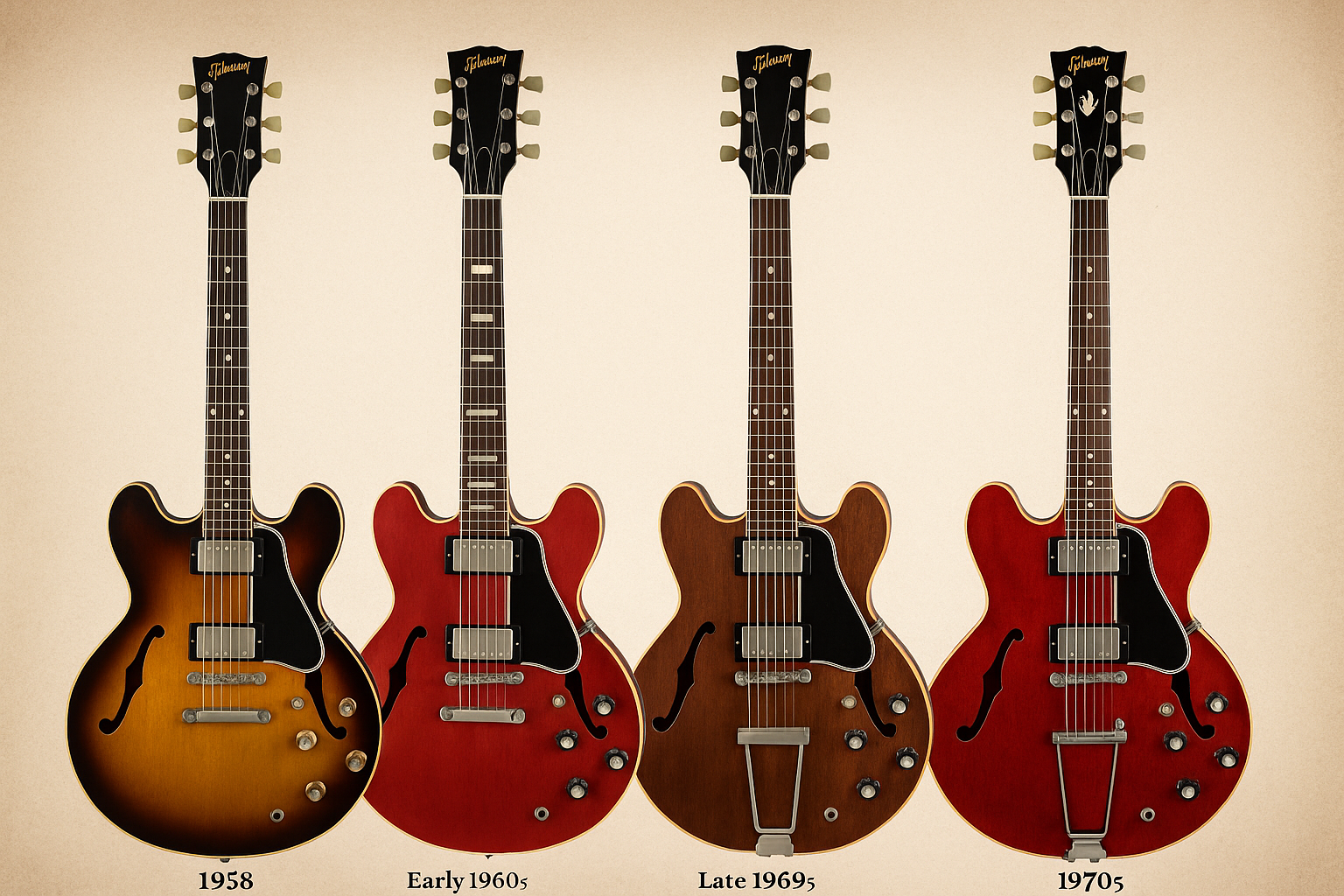Few electric guitars have achieved the iconic status of the Gibson ES-335. Introduced in 1958, the ES-335 bridged the gap between solid-body and hollow-body guitars, offering a revolutionary semi-hollow design that delivered both sustain and warmth. From jazz to blues to rock, the ES-335 became a genre-crossing staple. Let’s take a deep dive into how this legendary model evolved between its debut in 1958 and the dawn of the 1980s—and which legendary players helped define its legacy at each stage.
1958: The Birth of a Classic
The Gibson ES-335 made its debut in 1958 as the first commercially available semi-hollow body electric guitar. Designed by Ted McCarty, it featured a solid maple center block running through the body to reduce feedback—a common issue in fully hollow guitars—while still preserving the resonance of a hollow-body design. Early models had:
-
A rounded “Mickey Mouse ear” double-cutaway shape
-
PAF (Patent Applied For) humbuckers
-
Dot inlays on a rosewood fretboard
-
A stop tailpiece and ABR-1 Tune-o-matic bridge
Famous Players:
-
Chuck Berry: Known for his energetic performances and classic hits like “Johnny B. Goode,” Berry’s ES-335 helped define the image of rock ‘n’ roll.
-
Larry Carlton: Although he rose to prominence slightly later, Carlton’s use of early ES-335s gave jazz fusion a smooth, articulate voice.
Early 1960s: Subtle Refinements
Between 1961 and 1965, Gibson made a few notable changes:
-
1961: The dot markers were replaced by small block inlays.
-
1962: The neck profile became slimmer—favouring faster playing styles.
-
1965: Gibson switched from wide “stop” tailpieces to trapeze tailpieces, which many players found less desirable in terms of sustain and tuning stability.
Famous Players:
-
Freddie King: The Texas blues giant favoured a 1961 cherry red ES-345 (a close cousin to the 335), known for his biting tone and aggressive attack.
-
B.B. King: Though associated more with the ES-355 and “Lucille,” his playing helped popularise the entire ES semi-hollow family.
Late 1960s: Norlin Era Begins
The late ’60s marked the beginning of Norlin Industries’ ownership of Gibson, bringing with it several shifts in production and design:
-
1967–1969: Neck profiles became even slimmer, and Gibson began using a volute (a reinforced area behind the headstock).
-
The nut width narrowed from 1 11/16” to 1 9/16” by 1965–1969, which some players felt was too tight for comfortable playing.
-
Gibson introduced a walnut finish and altered the body shape subtly, though many of these changes were cosmetic.
Famous Players:
-
Alvin Lee: His heavily modified ES-335, nicknamed “Big Red,” became legendary after his blistering Woodstock performance with Ten Years After.
-
Eric Clapton: Used a 1964 ES-335 during his time with Cream, especially notable during the Farewell Concert in 1968.
1970s: Heavy Hands, Heavy Changes
The 1970s saw more dramatic changes, not all of them well-received:
-
1970–1972: Gibson introduced a “Made in USA” stamp on the back of the headstock.
-
Laminated maple necks replaced the one-piece mahogany necks for added strength but altered the tone.
-
Multi-piece necks became common, and the “Norlin era” emphasis on cost-cutting led to heavier guitars due to thicker finishes and more substantial hardware.
-
The “boomerang” or “witch hat” knobs became standard.
-
Some models featured coil taps, trapeze tailpieces, or even TP-6 fine-tuning tailpieces.
Famous Players:
-
Ritchie Blackmore: While better known for his Strat, Blackmore occasionally used an ES-335 in the studio.
-
Dave Grohl (retroactively): Though he rose to fame in the ‘90s, Grohl’s custom DG-335 is based on the ‘70s Trini Lopez model—highlighting the lasting influence of this era’s design.
The Legacy by 1980
By the end of the 1970s, the ES-335 had undergone numerous transformations—some cosmetic, some structural. While purists often prefer the 1958–1964 “golden era” models for their tone and build quality, the 1970s iterations introduced features that appealed to a new generation of players looking for durability and versatility.
Today, vintage ES-335s from each era have their own fanbase. Whether it’s the warm, round tones of the early models or the rock-solid builds of the Norlin era, the guitar’s adaptability has secured its place in music history.
Final Thoughts:
From Chuck Berry’s primal rock riffs to Larry Carlton’s jazzy sophistication, the Gibson ES-335 has been in the hands of music royalty across decades. Its evolution between 1958 and 1980 tells a story not only of changing tastes and manufacturing methods but of how innovation continues to shape sound.









